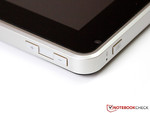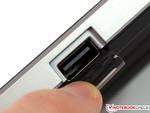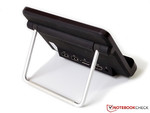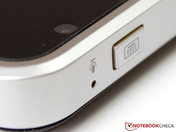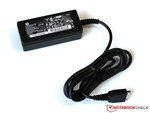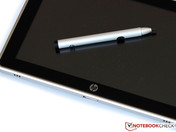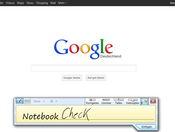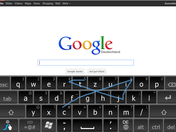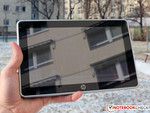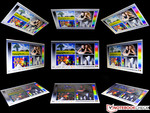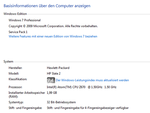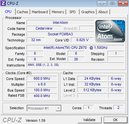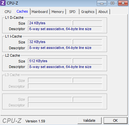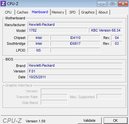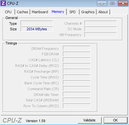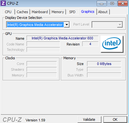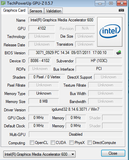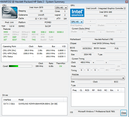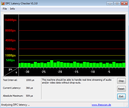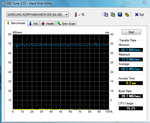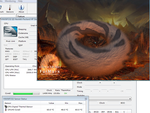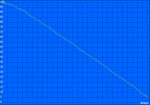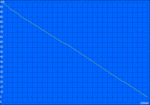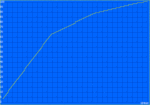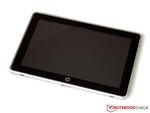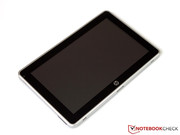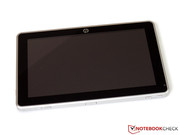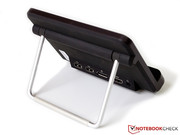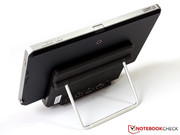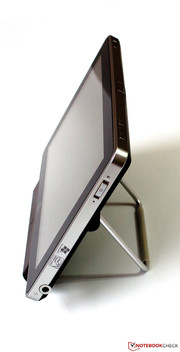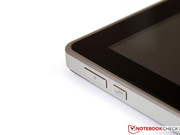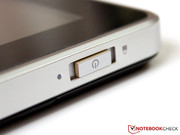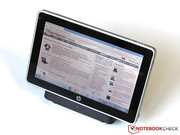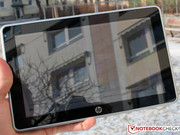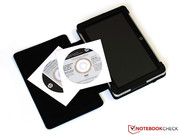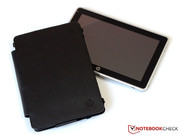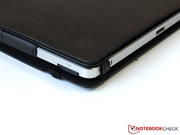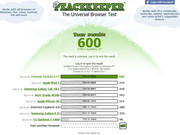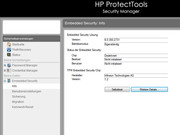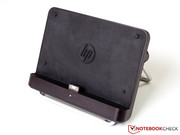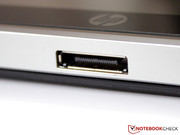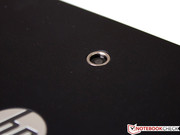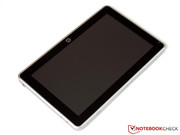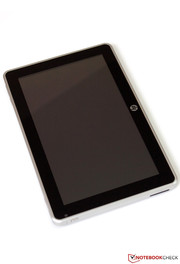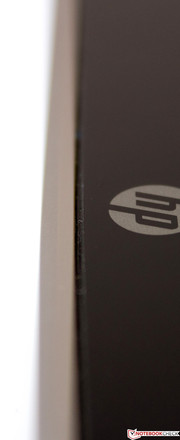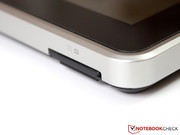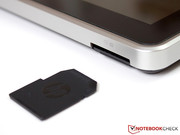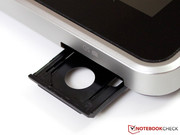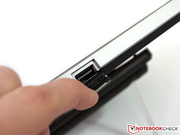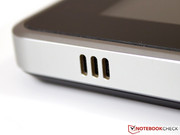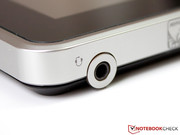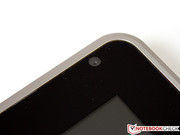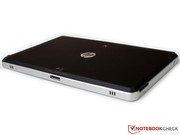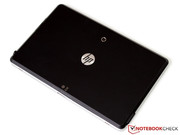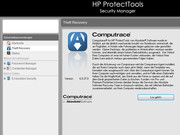Review HP Slate 2 Wi-Fi + 3G Tablet

Since the first iPad appeared just about two years ago, the Tablet PC market has grown with almost unbelievable speed. After the top dog Apple and their iOS, Google also established their Android operating system, similarly developed specifically for use with mobile devices.
Despite the steadily growing multitude of apps for both platforms, there are still some buyers, especially in the business world, who are forced to stick with Windows - be it just for the Office package or for specifically developed software. HP is one of the few big manufactures concentrating on this area. At the end of 2010, the Slate 500 with Windows 7 was brought to the market and, despite the high price of 800 dollars for a 8.9 inch Tablet, the company couldn't complain about a dearth of demand.
For the Slate 2, HP slightly revised the preceding model and replaced the former Atom Z540 with a more modern Atom Z670. Also on board are 2 GB RAM, a 64 GB SSD, and a fast 3G module, everything for a very self-confident price of 750 Euros. About 100 Euros cheaper is the base model with only 32 GB of storage and missing UMTS support.
Compared to the overwhelming selection of Android Tablets, the Slate 2's competition is pretty small. The hottest competitor next to the Dell Latitude ST is the Fujitsu Stylistic Q550, which we reviewed in detail last year. Whether HP took on the necessary task of improving the user-friendliness of Windows Tablets will now be closely examined.
Case
From the looks of it, HP decided to use the case of its predecessor, the Slate 500, without making any changes. With its format of 23.4 x 15 centimeters, the 8.9 inch Tablet is distinctly smaller than, for example, an iPad 2, but because of its enormous thickness of 15 millimeters (iPad 2: 8.8 millimeters) it feels very cumbersome. The weight of about 700 grams also means the Slate 2 gets a little unwieldy with time, though there are considerably heavier devices out there, like Fujitsu's Stylistic Q550 (850 grams).
The color scheme gives a rational, businesslike impression. Black and matte-silver surfaces characterize the design, which is more of secondary relevance in the business sector anyway. Substantially more important is the qualitative aspect, which the tablet masters with bravura. Although everything besides the glass plate in front of the display is made of plastic, HP's Slate 2 inspires enthusiasm with its outstanding stability. Even under strong pressure the tablet didn't warp or make cracking sounds. The beveled case corners, like the whole case, are cleanly manufactured and provide no room for criticism. In the end we did find one little flaw: on our test model we saw a narrow gap between the bottom corner of the display and the frame, which the first dust particles to come along would happily occupy.
Instead of installing grips, the manufacturer covered the back side with a light rubber coating, which is convincing in its high-quality haptic and good adhesion. On the front side, fingers find space on the two centimeter-wide display frame. The frame, unfortunately, revealed itself to be quite sensitive to dust or fingerprints, which could have been avoided with a more matte coating.
All in all, the manufacturing of the device is at an extremely high plane. The stated points of criticism would only be visible to even the most meticulous buyer at very close inspection. In light of that, the self-imposed business demand is distinctly better suited to the Slate 2 than the Q550 - only Apple's iPad 2 sets itself further apart with its exemplary quality.
Connectivity
Considering the thickness of the device, HP could have had plenty of space to install a true armada of connections. The manufacturer unfortunately did not use this possibility, though the Slate 2 does offer a few connectivity options. On the front side is a full USB 2.0 port, hidden under a little door to protect it from dirt and moisture. With that, the buyer of an HP Tablet will never encounter the occasional difficulty an iPad user has trying to quickly copy data from a USB stick or external hard drive. Alternatively, a card-reader in SD format is also available.
Except for a 3.5 millimeter headphone jack on the right side, all the rest of the ports are only available through the included docking station. Here, next to two more USB 2.0 ports and another headphone jack, an HDMI output (maximum resolution: 1600 x 1200 pixels) is also at your disposal, though we would have liked that directly on the device: Those who would like to operate a beamer or an external monitor on the go would certainly be better served with such a solution. Fujitsu's Q550, and also many Android models, like the new Asus Transformer Prime, offer HDMI/Micro HDMI even without a circuitous route through the docking station.
In order to satisfy the requirements of a Windows device with a Tablet, various hardware keys are installed on the side of the device. These serve, among other things, to open or close the on-screen keyboard - which unfortunately does not always open automatically with the selection of an input field -, to control the volume, to show the desktop, or to open the Task manager, for example, via the "three finger salute" (CTRL + ALT + DEL).
Communication
Except for the missing wiMAX support, the HP Slate 2 commands nearly every wireless standard that a user could possibly fathom desiring. The WLAN adapter, an Atheros AR6003, connects to both the 2.4 and 5 GHz bands on networks of the version 802.11a/b/g/n.
As a special mobile sector-oriented solution, the AR6003 sends out only one stream, which negatively affects the transfer speed (maximum 85 MB/s gross data rate), but in return positively affects the level of power consumption.
Furthermore, for cell phones or peripheral devices, the current Bluetooth standard 4.0 + HS is available. Among other things, this version was supplemented with a new low energy mode, which should save energy primarily due to the especially short time needed to establish the transmission path of the network.
For a second wireless module, HP integrated the firm-original un2430 EV-DO/HSDPA Mobile Broadband Module. This makes possible data transfer rates up to 14.4/5.76 MB/s (download/upload) in accordingly developed UMTS/HSPA networks, and positioning via GPS. The slot for the SIM card is hidden, but easily accessible, directly adjacent to the SD card reader.
Webcam and Microphone
Like most of the competition, the Slate 2 is furnished with two Webcams. For video chats, on the front side there is a disappointingly low-quality 0.3 Megapixel sensor, which displays a lot of noise at mid-brightness. Because the lens is hidden in a corner of the display frame, the camera can be used in both portrait and landscape format without getting covered by the user's hands. One disadvantage of this positioning, however, is that the picture detail is always a little harsh, though from a distance of more than 40 centimeters that is no longer a problem.
The 3.0 Megapixel camera on the backside puts up a bit of a better show. Videos are recorded at a maximum of 640 x 480, but they can't keep up with resolution of a good cell phone camera. The 8 Megapixel sensor on the Asus Transformer Prime is playing in a totally different league.
It's no exhibition, but the sound quality of the built-in microphone is acceptable and understandable. For occasional chats, for example via Skype, an additional headset is definitely not necessary.
Security
Next to x86 compatibility, extensive security features are the distinguishing mark that should convince business customers to get the HP Tablet. The Slate 2 possesses now by default a TPM 1.2 Embedded Security Chip, which is meant, among other things, to guarantee greater security for digital certificates, user authentication, and saved data. The so-called "Computrace Pro" software is supported through the BIOS, and helps to locate a stolen device via GPS and WLAN. The data on the hard drive can be secured from afar and the system can be locked.
Accessories
Going against the current market trend, HP show themselves to be exceptionally generous with what they include in the Tablet's box. Along with the usual brochure packet, recovery DVD and Windows storage volume, we also found a high-quality leather bag, a dust cloth, the stylus and its necessary batteries (AAAA/LR61), and - especially curiously - two identical 30 watt power supplies.
Also included in the packaging is a folding docking station, which serves both to provide additional connectivity options (see the Connectivity section) and to hold the device in place for stationary use. The Tablet slides easily and perfectly in its mount, to remove it you'll need to stabilize the dock with a second hand.
Service
Since the backside is fully sealed and there are no visible screws, no components can be upgraded or modified. The only thing you can do to enlarge storage capacity is to utilize an SD card.
Warranty
If you purchase the HP Slate 2 at a retail store, you'll only get a 12-month manufacturer's warranty. But most companies will acquire the Tablet without the additional Care Pack from the manufacturer, which for a price of about 140 Euros offers a 3-year-long pick-up and delivery service. It's to be expected that under certain circumstances HP will also offer large company clients both rebates as well as further warranty packages.
Input Devices
Windows and touch-operation - with this combination we haven't exactly had the greatest experiences in the past. First we want to try to operate the Slate 2 exclusively with the finger.
Touchscreen
From the start: These input methods should be better avoided. Even if Microsoft strove to optimize Windows 7 for touchscreens, the usefulness lags far behind that of Android or iOS. The problems start right off with tiny size of the icons and drop-down menus, which can only be hit with difficulty, despite the lower pixel density of the display. Some everyday Windows functions, like changing the size of a window, are practically impossible to do with a finger. Thanks to the support of multi-touch gestures, surfing the internet is a little easier, but all in all we must say: Windows 7 is and remains an operating system that is conceptualized for laptops or PCs and is best used there. The touchscreen, which in principal reacts with precision, is not at fault for that.
Stylus
Under these limitations, of course, the manufacturer HP can do very little, but they try to make the best of it. Remedy is provided first by the enclosed active stylus, which fulfills two functions. First, with it the mouse can be precisely positioned almost down to the pixel, and right-clicks are made possible with the help of a key on the stylus itself. Further, any input field can be filled out with the help of Windows' handwriting recognition, which has an astoundingly low rate of error, even when you're writing fast. Unfortunately, as is true with the Fujitsus Q550 as well, the stylus cannot be stored in the device itself.
Distinctive features
As an alternative to Windows 7's on-screen keyboard, HP also installed a so-called Swype keyboard. Using this keyboard, words can be written by scanning over the letters, rather than having to individually select each one - a solution you might be familiar with on your smart phone. Unfortunately, when we started Swype on our test model it showed an error message and quit - and an update to the newest version didn't solve the problem.
Display
As the central component of a Tablet, the display on the Slate 2 is accorded great importance. HP employs an 8.9 inch panel with a native resolution of 1024 x 600 pixels, which results in a pixel density of 133 dpi - comparable to an iPad 2 at 132 dpi.
Since the small number of lines can be problematic for some uses, an interpolated resolution of 1024 x 768 pixels can also be set, which of course makes the display sharpness much worse. In addition it causes serious distortion, since the aspect ratio of 4:3 doesn't fit the dimensions of the display.
| |||||||||||||||||||||||||
Brightness Distribution: 83 %
Center on Battery: 136 cd/m²
Contrast: 618:1 (Black: 0.22 cd/m²)
44.99% AdobeRGB 1998 (Argyll 3D)
62.7% sRGB (Argyll 3D)
43.71% Display P3 (Argyll 3D)
The picture quality of the panel can't keep up with the norm for the tablet sector, unfortunately. The LED backlight manages only 121 cd/m², which is only enough for interior use, and that at best. In addition there is a slight "backlight bleeding" - on the bottom edge, dark colors are displayed with uneven brightness. All that aside, at 83 percent the illumination level is acceptable, even if it's not outstanding.
Thanks to a good black value of 0.22 cd/m², the contrast of 618:1 is at least persuasive. The Fujitsu Stylistic Q550 as a direct competitor, with a contrast of 753:1, is playing in the same arena, but the current market leader is the Asus Transformer Prime with an impressive 1836:1.
Of course there will be very few users who want to do professional image editing on a small and lower performance tablet - and the Slate 2's display is not fit for that. The color gamut is a little wider than Acer's Iconia W500 or the Q550 by Fujitsu, but it can't completely cover the standards AdobeRGB and sRGB. Subjectively, though, the image is compelling and should be good enough for all common uses.
Although HP talks about an anti-glare coating on the display in their specifications, in practice you recognize distinct reflections. In conjunction with the low maximum brightness, use outdoors is considerably impeded - even in cloudy weather it's hardly possible. This is beyond aggravating, especially for a mobile Tablet with 3G support, since even far cheaper models by other companies do a better job. HP should simply install a far more powerful backlight - one that reaches a light density of 300 cd/m² or more.
The Slate 2's display originates with the manufacturer CMO (N089L6-L03) and is based on the TN technology. When you're talking about such a pricey device, a high-quality IPS or VA panel should be compulsory, especially in a Tablet. As a result the angle of vision is pretty limited - minor distortions can be observed even with just a few degrees of deviation from the optimal perspective, especially in terms of the vertical angle. But in contrast to even lower-quality displays on most laptops, the image content remains at least legible over a truly wide range of perspectives, which is a satisfactory finding.
Performance
The predecessor model Slate 500, with its 1.86 GHz Intel Atom Z540, already couldn't have been called a performance wonder, but the now-installed Atom Z670 (codename Lyncroft) at 1.50 GHz climbs a few rungs further down the ladder. According to HP, the reason for the switch was the lower power draw of the new model, which despite the (obsolete) 45 nanometer production possesses a TDP of a mere 3 watts. Thanks to the SoC construction of the Oak Trail platform, all the components that were contained in the Atom Z540 chipset, like the storage controller or graphics card, are also found in this chip.
The actual in-order core processor has hardly changed a bit since the first Atom generation in the beginning of 2008. Because of that, the Pro MHz performance of the single-core CPU is extremely poor - even AMD's C series APUs are considerably quicker. The multithread performance is somewhat improved by the SMT technology, but the rest of the feature set seems antiquated at this point: no 64-bit support, SSE only up to version 3, neither AVX nor AES-NI.
Despite the label Intel GMA 600, the graphics unit originally came from PowerVR. The chip integrated into the CPU die, named SGX 535, offers about the computing performance of Nvidia's Tegra 2 (both 3.2 GFLOPS) - but current ARM-based high-end smartphones or Tablets are already much faster. Compared with other GPUs from the laptop sector the GMA 600 falls even further behind, which we will look at more closely on the basis of 3D benchmarks. The manufacturer promises that at least current video codecs can be comprehensively accelerated, including MPEG4, VC1, H.264 and DivX, among others.
With 2 GB DDR2-800 and a 64 GB SSD, the Slate 2 is quite generously endowed. Compared with Android Tablets, which generally contain only 512 to 1024 MB of RAM, it should be taken into consideration that the Windows operating system eats far more storage space and occupies several hundred megabytes even in idle mode.
Processor
The Atom Z670 already became a disappointing memory for us in the Fujitsu Stylistic Q550. But in our current review candidate from HP the benchmark results in the Cinebench R10 (32 bit) look a little better: 500 points in the single rendering test, 777 points under the use of SMT lay 21 to 45 percent over the performance of the competition. But that can't blind us to the fact that we're moving in the absolute low-end sector - even an AMD C-60 yields up to double the value, an entrance-level laptop with Intel's Pentium B940 reaches up to 5 to 7 times that value.
Mass storage
Due to the shortage of space, HP lays their money on a compact mSATA SSD by Samsung (MZMPA064HMDR), which we just saw in the Samsung 900X1B. Unfortunately the Slate 2 doesn't quite reach the transfer rates that device achieves, depending on the program we got to somewhere between 66 and 161 MB/s while reading and 71 to 170 MB/s while writing. These are also completely respectable values, in practice the data medium should seldom come to a bottleneck. At 0.2 milliseconds the access time is pretty low, which is typical for an SSD, and especially accelerates the boot time: about 30-35 seconds is quite speedy for the Atom platform, and at under 5 seconds the wake time from standby mode is also pleasantly quick.
It is necessary to take note of the very high CPU usage, which is over 15 percent during sequential operations. Here once again the Atom Z670's limited power reserves are noticeable.
System Performance
The processor is also the chief cause of the Tablet's weak system performance. Despite the quick flash memory the PCMark Vantage gave only 1146 points - nevertheless, the PCMark 7 posted 849 points, which is the typical performance range of a netbook.
In the day to day, the shortcomings of the computing performance are perceptible in many places. Even the shifting of a window on the desktop is executed with a slight jerking - many actions are only performed after the computer has had a second to think. In general we have to advise against demanding tasks, even surfing the internet is agonizingly slow: large websites take several seconds to load and scrolling is only rarely fluid - at least with the pre-installed Internet Explorer 9.0. The browser has an enormous influence over the results of the following benchmarks, which is why we have included Google's Chrome (version 16.0) for comparison.
Depending on the program, the Slate 2 sometimes comes in before, but sometimes far behind the competitors with Android and iOS. In the Peacekeeper Test by Futurmark we arrived at 280 or 600 points, in the Google V8 benchmark 514 and 1874 points, and the SunSpider JavaScript benchmark finished with 1199 respective of 1700 milliseconds.
As you can see, Chrome's performance stands in strong contrast to that of its Microsoft counterpart. Though such a difference is rarely noticeable on fast laptops, it is necessary to install a quick browser on netbooks or Windows Tablets. Subjectively, the responsiveness of the Atom platform itself seems a little sluggish, which becomes apparent during the automatic rotation of the display image, too: It takes up to 4 seconds to switch from portrait to landscape format and vice versa.
| PCMark Vantage Result | 1146 points | |
| PCMark 7 Score | 849 points | |
Help | ||
Graphics
Instead of testing with the current 3DMark versions, we limited ourselves to some older editions for the Intel GMA 600, since these newer versions require a lot of the graphics unit. The scores obtained align with the Fujitsu Stylistic Q550 at best. Even the 11-year-old 3DMark 2001 jerks around and doesn't allot more than 1549 points, which disqualifies the tablet for gaming use almost completely.
We then decided to try out a few mere flash games in the browser, which sometimes ran well, sometimes not. The biggest problem is usually that the input isn't designed for touchscreens - another advantage of operating systems like Android. In addition, the games in the Google and Apple marketplaces are better optimized for the limited performance of mobile devices, though the users of the more professionally targeted HP Slate 2 are unlikely to be interested in this point.
A smooth rendering of video material would be more important. Although the graphics unit should be able to handle HD trailers up to 1080p, even at 720p occasional frames are dropped. At full HD-resolution this happens a lot, but at more than 20 fps the rendering remains largely fluid. This is a clear improvement over older Atom generations, which could only master a mere 480p without difficulty.
| 3DMark 2001SE Standard | 1549 points | |
| 3DMark 03 Standard | 747 points | |
| 3DMark 05 Standard | 265 points | |
Help | ||
Emissions
System noise
HP's Slate 2 operates just as silently as we expect from a Tablet PC. Neither the hum of a mechanical hard drive nor the bothersome whirring of fans can be heard, regardless of whether the device is in idle mode or under a full load. The economical Atom SoC is passively cooled, thanks to its low TDP of a mere 3 watts - on other Windows devices with Fusion APU or ULV CPU by Intel this is not possible. Android models or Apple's iPad also do without fans, since their ARM-chips consume even less power.
Temperature
We can't speak as positively of the temperature progression of the tablet. Even in idle mode the backside crosses the 40°C mark in many spots - under full load we recorded a maximum of 46.1 degrees Celsius. While the outside temperatures remain below freezing, this shouldn't be a problem, but in the summer sweaty hands are basically pre-programmed. Since other Tablets with comparable hardware don't have problems like this, it would appear HP's passive cooling system isn't sufficiently dimensioned. If they had used an aluminum case with higher thermal conductivity, temperatures may have been a little lower, as for example the Asus Transformer Prime proves.
Nothing critical can be said about the warmth of the Atom SoC, which hardly reaches above 60 degrees Celsius. Neither throttling nor stability problems were observed, even with the simultaneous burden of both FurMark and Prime95.
(+) The maximum temperature on the upper side is 37.2 °C / 99 F, compared to the average of 33.7 °C / 93 F, ranging from 20.7 to 53.2 °C for the class Tablet.
(-) The bottom heats up to a maximum of 46.1 °C / 115 F, compared to the average of 33.2 °C / 92 F
(±) In idle usage, the average temperature for the upper side is 33.1 °C / 92 F, compared to the device average of 30 °C / 86 F.
Speakers
The sound quality of the Tablet is disappointing. Still, the manufacturer built in two speakers that make stereo-playback possible, which the Q550 by Fujitsu had to forego.
The sound proceeding from the two openings on the underside only serves as a less-than-ideal solution. Music sounds flat and treble-prone, bass isn't audible. But conversations via Skype or other chat programs are easily understandable, even if they do make a bit of a metallic impression.
The sound of an external speaker system or headphones is much better. These can be connected via the 3.5 mm jacks on either the docking station or the tablet itself.
Battery Life
Power consumption
The technological kinship with netbooks based on Intel's Atom CPU becomes clear in the measurement of power consumption. 4.5 to 6.1 watts in idle mode are excellent values in this sector, but they lay only a little beyond the level of ARM devices - the much higher performance Asus Transformer Prime with a quad-core SoC and extremely bright 10-inch display manages with 3.6 to 6.7 watts.
Under load we see a similar picture. In absolute terms, a maximum of 10.3 watts is good, but in relation to the weak background illumination and the low performance, these are no top values. Along with the Atom Z670, Windows 7 is also responsible for this, since it has not been optimized for energy-saving tablets or smartphones, unlike the competing operating systems.
| Off / Standby | |
| Idle | |
| Load |
|
Key:
min: | |
Battery life
A 30 watt-hour battery should be sufficient for a battery life of up to 6 hours - with this estimate HP really understates the case. In idle mode, using the Battery Eater Reader's test with the best possible energy-saving settings, we reached over 8 hours far away from the power outlet.
Activating WiFi, we still surfed the internet for 5 hours and 35 minutes. The display brightness was maximized, but it was still below our standard value of 150 cd/m² for this test, which for the Slate 2 is simply impossible.
If we work the Tablet to capacity with the Battery Eater Classic Test, the battery life falls to 3 hours and 36 minutes. In less than 3 hours the battery is fully loaded again and ready for the next use.
As the performance has already hinted, the battery life can't quite keep up with the ARM competitors. Even the almost identically-equipped Fujitsu-Tablet offers somewhat better mobility, mostly thanks to its large 38 watt-hour battery.
Verdict
How wonderful it could be: The whole diversity of the x86 platform on a compact tablet, total compatibility with the available peripheral devices, independence from the marketplaces in Android and iOS. The appeal of devices like the HP Slate 2 isn't just for businesses.
But the limits in practice cloud this euphoria quickly. Microsoft's operating system is, at least up until now, hardly recommendable for tablets. Flawless operation is only possible with the stylus, many icons or menus are simply too small to select with a finger. We will have to wait and see if the coming Windows 8 will bring with it decisive improvements.
The second stumbling block is the slow Atom processor. Even with everyday tasks, for instance surfing the internet, this processor is strained - it jerks and falters everywhere, productive work is thereby limited.
Both problems can only be partially heaped on the manufacturer HP. Higher performance hardware would be connected to other limitations and would definitely force more intense heat. The much too dark TN panel, however, can certainly be criticized: considering this is a 750 euro device, this was the wrong place to economize.
But there are still rays of hope: the top-quality manufacturing is absolutely perfect for the targeted business segment, and similarly, the generous furnishing with a fast SSD and integrated UMTS deserves plus points. Companies that need an x86 Tablet with comprehensive security features will prefer the Slate 2 to other consumer devices like the Apple iPad 2 or Asus' Transformer Prime, despite all its weaknesses. Models like the Fujitsu Stylistic Q550 or the Dell Latitude ST, however, offer truly comparable packages.




